Weicheng Gao
Through-the-Wall Radar Human Activity Recognition WITHOUT Using Neural Networks
Jun 05, 2025Abstract:After a few years of research in the field of through-the-wall radar (TWR) human activity recognition (HAR), I found that we seem to be stuck in the mindset of training on radar image data through neural network models. The earliest related works in this field based on template matching did not require a training process, and I believe they have never died. Because these methods possess a strong physical interpretability and are closer to the basis of theoretical signal processing research. In this paper, I would like to try to return to the original path by attempting to eschew neural networks to achieve the TWR HAR task and challenge to achieve intelligent recognition as neural network models. In detail, the range-time map and Doppler-time map of TWR are first generated. Then, the initial regions of the human target foreground and noise background on the maps are determined using corner detection method, and the micro-Doppler signature is segmented using the multiphase active contour model. The micro-Doppler segmentation feature is discretized into a two-dimensional point cloud. Finally, the topological similarity between the resulting point cloud and the point clouds of the template data is calculated using Mapper algorithm to obtain the recognition results. The effectiveness of the proposed method is demonstrated by numerical simulated and measured experiments. The open-source code of this work is released at: https://github.com/JoeyBGOfficial/Through-the-Wall-Radar-Human-Activity-Recognition-Without-Using-Neural-Networks.
Generalization Ability Analysis of Through-the-Wall Radar Human Activity Recognition
Oct 10, 2024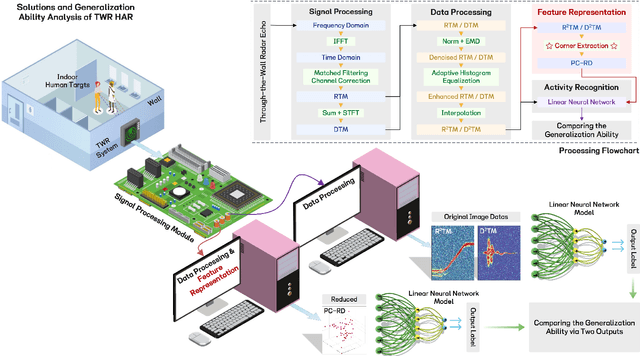
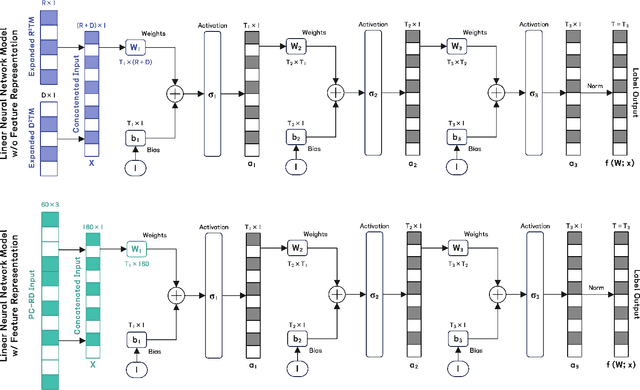
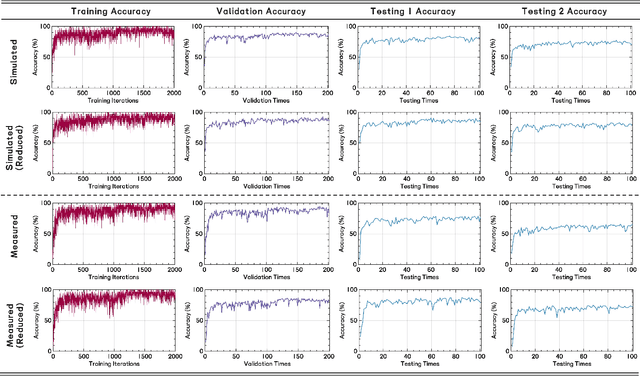
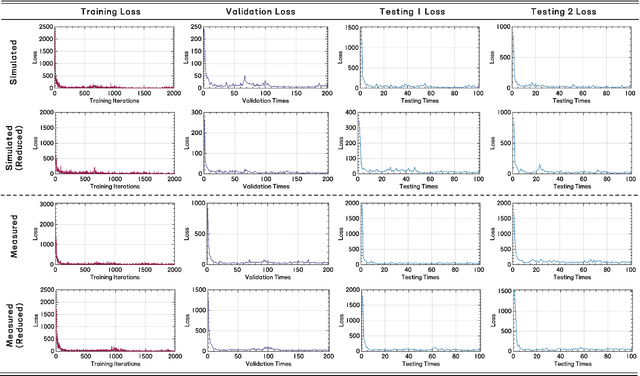
Abstract:Through-the-Wall radar (TWR) human activity recognition (HAR) is a technology that uses low-frequency ultra-wideband (UWB) signal to detect and analyze indoor human motion. However, the high dependence of existing end-to-end recognition models on the distribution of TWR training data makes it difficult to achieve good generalization across different indoor testers. In this regard, the generalization ability of TWR HAR is analyzed in this paper. In detail, an end-to-end linear neural network method for TWR HAR and its generalization error bound are first discussed. Second, a micro-Doppler corner representation method and the change of the generalization error before and after dimension reduction are presented. The appropriateness of the theoretical generalization errors is proved through numerical simulations and experiments. The results demonstrate that feature dimension reduction is effective in allowing recognition models to generalize across different indoor testers.
Generalizable Indoor Human Activity Recognition Method Based on Micro-Doppler Corner Point Cloud and Dynamic Graph Learning
Oct 10, 2024



Abstract:Through-the-wall radar (TWR) human activity recognition can be achieved by fusing micro-Doppler signature extraction and intelligent decision-making algorithms. However, limited by the insufficient priori of tester in practical indoor scenarios, the trained models on one tester are commonly difficult to inference well on other testers, which causes poor generalization ability. To solve this problem, this paper proposes a generalizable indoor human activity recognition method based on micro-Doppler corner point cloud and dynamic graph learning. In the proposed method, DoG-{\mu}D-CornerDet is used for micro-Doppler corner extraction on two types of radar profiles. Then, a micro-Doppler corner filtering method based on polynomial fitting smoothing is proposed to maximize the feature distance under the constraints of the kinematic model. The extracted corners from the two types of radar profiles are concatenated together into three-dimensional point cloud. Finally, the paper proposes a dynamic graph neural network (DGNN)-based recognition method for data-to-activity label mapping. Visualization, comparison and ablation experiments are carried out to verify the effectiveness of the proposed method. The results prove that the proposed method has strong generalization ability on radar data collected from different testers.
Through-the-Wall Radar Human Activity Micro-Doppler Signature Representation Method Based on Joint Boulic-Sinusoidal Pendulum Model
Aug 22, 2024


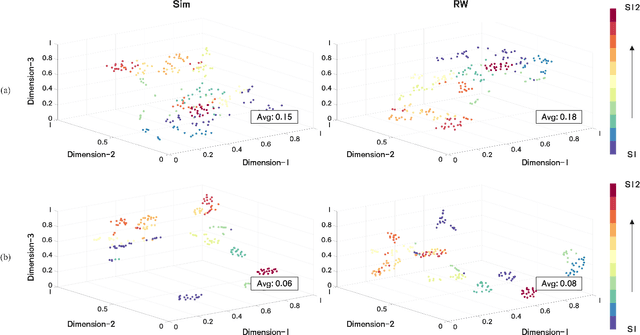
Abstract:With the help of micro-Doppler signature, ultra-wideband (UWB) through-the-wall radar (TWR) enables the reconstruction of range and velocity information of limb nodes to accurately identify indoor human activities. However, existing methods are usually trained and validated directly using range-time maps (RTM) and Doppler-time maps (DTM), which have high feature redundancy and poor generalization ability. In order to solve this problem, this paper proposes a human activity micro-Doppler signature representation method based on joint Boulic-sinusoidal pendulum motion model. In detail, this paper presents a simplified joint Boulic-sinusoidal pendulum human motion model by taking head, torso, both hands and feet into consideration improved from Boulic-Thalmann kinematic model. The paper also calculates the minimum number of key points needed to describe the Doppler and micro-Doppler information sufficiently. Both numerical simulations and experiments are conducted to verify the effectiveness. The results demonstrate that the proposed number of key points of micro-Doppler signature can precisely represent the indoor human limb node motion characteristics, and substantially improve the generalization capability of the existing methods for different testers.
TWR-MCAE: A Data Augmentation Method for Through-the-Wall Radar Human Motion Recognition
Jan 06, 2023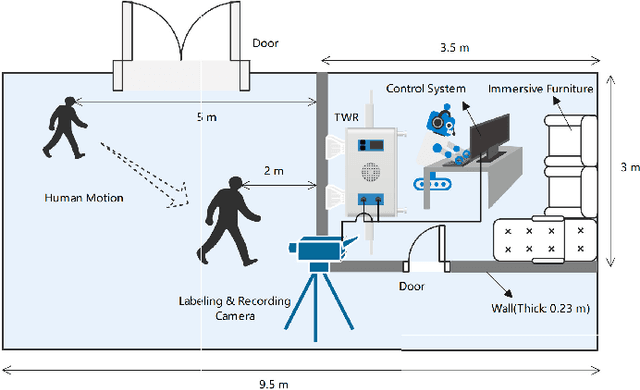



Abstract:To solve the problems of reduced accuracy and prolonging convergence time of through-the-wall radar (TWR) human motion due to wall attenuation, multipath effect, and system interference, we propose a multilink auto-encoding neural network (TWR-MCAE) data augmentation method. Specifically, the TWR-MCAE algorithm is jointly constructed by a singular value decomposition (SVD)-based data preprocessing module, an improved coordinate attention module, a compressed sensing learnable iterative shrinkage threshold reconstruction algorithm (LISTA) module, and an adaptive weight module. The data preprocessing module achieves wall clutter, human motion features, and noise subspaces separation. The improved coordinate attention module achieves clutter and noise suppression. The LISTA module achieves human motion feature enhancement. The adaptive weight module learns the weights and fuses the three subspaces. The TWR-MCAE can suppress the low-rank characteristics of wall clutter and enhance the sparsity characteristics in human motion at the same time. It can be linked before the classification step to improve the feature extraction capability without adding other prior knowledge or recollecting more data. Experiments show that the proposed algorithm gets a better peak signal-to-noise ratio (PSNR), which increases the recognition accuracy and speeds up the training process of the back-end classifiers.
* Publisher: IEEE Transactions on Geoscience and Remote Sensing (Volume: 60). Total Pages: 17. Total Figures: 17
 Add to Chrome
Add to Chrome Add to Firefox
Add to Firefox Add to Edge
Add to Edge